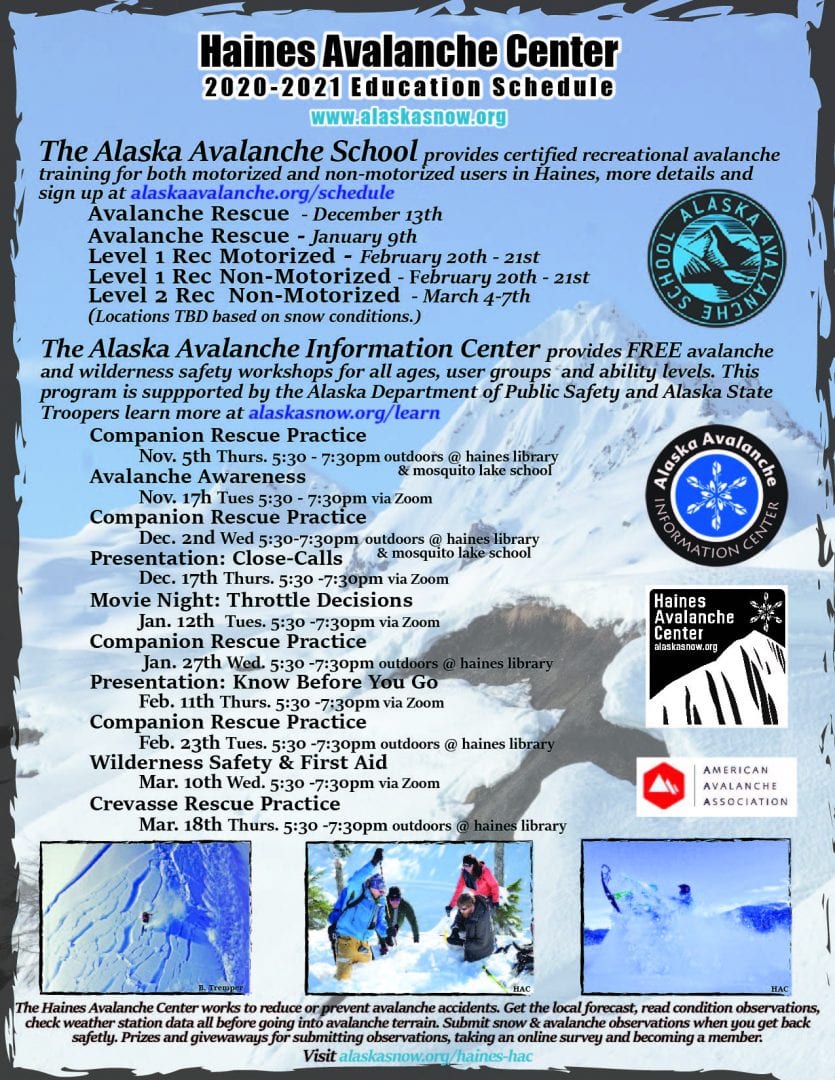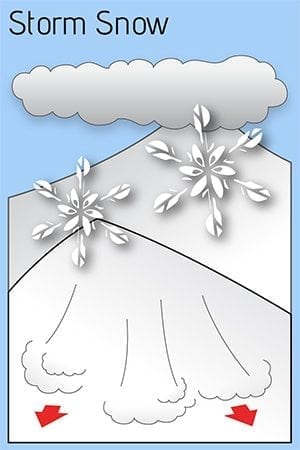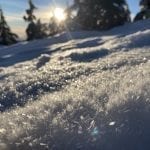Haines Avalanche Center
Above 2,500ftConsiderable
1,500 to 2,500ftConsiderable
Below 1,500ftConsiderable
Degrees of Avalanche Danger
Avalanche Problems
Problem 1
Snowfall totals overnight of 4-5″ of cold dry light snow transitioning to warmer wetter temps are setting up for an upside-down snowpack as the storm continues into the weekend. Increasing temperatures, precipitation (type/amount/rate) and winds speed all are important factors contributing to the storm snow problem. Be attentive to this current problem at hand, look for red flag signs of instability, cracking, whumphing or natural avalanches. Do quick hand pit shears, get off the main track & use low-consequence test slopes to help make stability assessments.
Likelihood:
- Almost Certain
- Very Likely
- Likely
- Possible
- Unlikely
Size:
- Historic
- Very Large
- Large
- Small
Trend
- Increasing
- Steady
- Decreasing
Problem 2
What we know, both zones up to 3000′ show poor structure (layers in the snow pack that could produce an avalanche) including melt-freeze crusts, buried surface hoar and near surface facets. It is best to assume spatial distribution is widespread until proven otherwise. Cold temperature gradients have weakening effects on these supportive crusts near the surface, close enough to the surface that they are prime for human triggering, especially in thin area near trees, rocks, cliffs and unsupported slopes. Keep in mind this problem can be triggered from far distance/not on the slab. Give respect to overhead exposure, look for convexities and identify hazardous terrain traps, or where snow could pile up quickly.
(Click photo to learn more about surface hoar at avalanche.org)
Likelihood:
- Almost Certain
- Very Likely
- Likely
- Possible
- Unlikely
Size:
- Historic
- Very Large
- Large
- Small
Trend
- Increasing
- Steady
- Decreasing
Problem 3
A steep temperature gradient from the ground at 32F and air temperatures 10-15F with melt-freeze crust vapor barriers are likely to exacerbate the presence of depth hoar and faceting (weakening of layers) below hard melt-freeze crusts. Be aware of outliers! The saturated mid-pack with a dry snow slab setup on top could also wreak havoc if triggered in the right spot. With a series of well-defined persistent layers above the deep slab concerns, the chances of an avalanche stepping-down are within the realm of possibility. Avoid 30° degree steep, exposed, open, planar, convex, or un-supported slopes, and terrain traps (cliffs, trees, rocks, gullies) especially any areas of drainage, where water could be flowing under the snowpack.
Likelihood:
- Almost Certain
- Very Likely
- Likely
- Possible
- Unlikely
Size:
- Historic
- Very Large
- Large
- Small
Trend
- Increasing
- Steady
- Decreasing
Avalanche Activity
Bottom Line: The snowpack is complicated right now. So are our emotions with the community response to a natural disaster in our home and the taxed EMS resources are exhausted from the immediate response and drawn out global pandemic. A range of freezing levels over the past two week & heavy precipitation coupled with variable spatial distribution of surface hoar/near surface facets (weak surface layers now buried) make it moderate to high confidant assessments difficult of what is really going on in the terrain
It is still early in the season, a good time to self check human factors/decision bias. We need to respect outliers (the unexpected) as it already has been heavy year. Be patient, take breaks, stop and smell the roses, or enjoy the view and company. Stay vigilant about the changing conditions, evaluate the hazards, think risk vs. reward and remember if snow is the problem, terrain is the answer. Choose low consequence slopes and carefully identify terrain traps and areas to avoid.
Weather
Temperature were in the mid-teen to low-twenties, with light to moderate north winds, and snow accumulation between 4-8″ of snow over the last 3-days. Winter storm warning is in effect until 5am Saturday with heavy snow expected 5-9″ and winds gusting as high as 45 mph Friday night. Temperatures are expected to rise Saturday into Sunday.
| Snow Depth [in] | Last 24-hr Snow/SWE [in] | Last 3-days Snow/SWE [in] | Today’s Freezing Level [ft] | Today’s Winds | Next 24-hr Snow/SWE | |
| Mount Ripinsky @ treeline | 72″ | 8″ / 0.08* | 8″+ / 0.08+* | Sea-level | N/A | 4″ / 0.04* |
| Flower Mountain @ treeline | 59″ | 4″ / 0.04* | 4″+ / 0.04+* | Sea-level | N/A | 4″ / 0.04* |
| Chilkat Pass @ 3,100ft | 13″ | 8″ / 0.08* | 8″ +/ 0.08+* | Sea-level | Light to Moderate, NW | 3″ / 0.03* |
( *star means meteorological estimate )
Additional Information
It’s time to start thinking avalanche. Dust off your gear and make sure it is fully functional. Put new batteries in your beacons! Do a beacon practice to start the season and keep your skills fresh. If you head into the hills, watch out for avalanche conditions, and be especially careful of rocks and hidden hazards like crevasses beneath the snow. WEAR A HELMET!

Education Video Links:
- AIARE
- How to Practice Avalanche Rescue Snowmobile Edition: https://youtu.be/2ML499MMDfM
- AK Sled Shed Motorized Learning:
- Intro: https://youtu.be/aoagKHfGkxs
- Personal Electronics in Avalanche Terrain: https://youtu.be/2Vz9S0OEyFk
- Snowmobile Macgyver Tool Kit: https://youtu.be/4WBNu_t6Bbk
- Head and Face Protection: https://youtu.be/jIzW89wOyZI
- Pre-season prep: https://youtu.be/zJmrb8cZlR4
- My Transceiver: https://youtu.be/yblaDWP7Jf8
- BCA Avalanche Safety for Snowmobilers
- How to Fix Common Snowmobile Problems in the Field: https://youtu.be/g9fiTxEvuFk
- Sleducation: Avalanche Safety for Snowmobilers: https://youtu.be/EWFOd_9DYb8
- Intro to Avalanche Transceivers for Snowmobilers: https://youtu.be/6ZLSBmsceog
- Avalanche Transceiver Trailhead Test for Snowmobilers: https://youtu.be/rWoXbadFBsY
- Avalanche Transceiver Searching Use Snowmobiles: https://youtu.be/w1ucyI6LMXM
- BCA Avalanche Rescue Series
- Beacon Search 101: https://youtu.be/nnHXLVA2FcE
- Avalanche Probing 101: https://youtu.be/-0_yDN5Drzw
- Avalanche Shoveling 101: https://youtu.be/dGQg9o3vAkM
- Organizing a Backcountry Rescue: https://youtu.be/gywtmukgt8s
- Post Avalanche Patient Care: https://youtu.be/9FyIeUy4wpQ
- Backcountry Evacuation: https://youtu.be/WPF-dciefL8
- Complex Multiple Burials Backup Techniques: https://youtu.be/pB6AfY2KyYo
- National Avalanche Center
- Avalanche Problems Explained: https://youtu.be/DkbnT_9-cHU
- Intro to North American Avalanche Danger Scale: https://youtu.be/r_-KpOu7tbA
Alerts
NEW forecaster for both the Transitional and Lutak Zones. Winter Storm Warning remains in effect until 5am Saturday. Get the forecast before heading out and submit an observation when you get home safely.
Announcements
We have begun conditions updates for winter 2020/2021. Click the + Full Forecast link below for each zone to read more.



